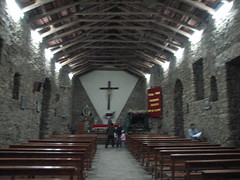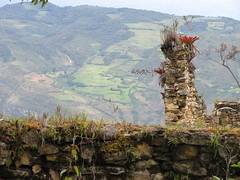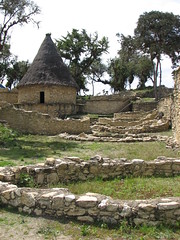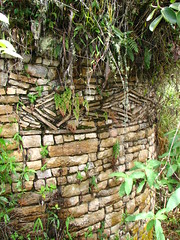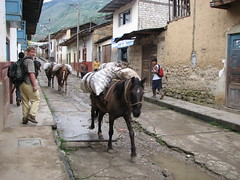Merry Christmas!
I hope everyone is having a good holiday and getting to spend all that family time and share all the yummy food that we’re not getting. Christmas here is different, but I’ve learned it differs from town to town as well. In our little mountain village there’s no Santa Claus, stockings, emphasis on presents or even a family meal together. We have been told people do trees but we have yet to see it. What they do have is giant nativity scenes in everyone’s houses with lichen, moss and bromeliads from the hills. On Christmas Eve, we assumed we’d be sharing a big family dinner…but that didn’t happen. All day they worked on the house they are building above the restaurant, did laundry and relaxed. Matt and I made pepper biscuits and I boiled a big batch of beans. We weren’t too hungry for dinner, so it was okay there was no family dinner (although a bit sad). The rest of the evening made up for it, though.
Here, people are all about the hot chocolate and panneton bread. The hot chocolate is artesanal and you start with the bean. Surprisingly, freshly made hot chocolate is pretty greasy. The bean has a lot of fat in it and when you toast, grind and cook the beans, the result is an oily chocolate drink. It differs obviously by the bean and we’ve had some good hot chocolate and some not so good hot chocolate. Last night Wilma invited us to share some of her homemade hot chocolate (the best so far) and some fresh made cheese (they went and brought back milk from their cows on their farm that morning) and panneton. The panneton is, for lack of a better description: fruit cake. Except it’s like a giant tall round loaf (think bread machine bread shape) of challah style bread filled with raisins and frutillas (think fruit snacks, but more sugar, less fruit). So, what you do is rip up the cheese (which tastes like a rubbery tofu), put it in your hot chocolate and dip the panneton in the chocolate and eat that with your hands. You eat the softened cheese with a spoon. The cheese in the chocolate is pretty good. The panneton…I am not excited about-but it wasn’t as bad as I thought it would be. Kids eat it here and pick out the fruit. Every other commercial on tv is for panneton. I think it originated in Italy, but it’s huge in Peru.
Estafani told me at her home in Chiclayo, they make their own panneton from scratch. They also have a big family dinner as well, so she was a little sad about the lack of family togetherness and homesick along with me.
That evening we went to the 10pm mass at the only church in town. The service was interesting…I was worried at first because the priest was this old white guy with a microphone that talked really loud and within the first 5 minutes of the service he rapped on the altar and yelled at the children to pay attention. I have never seen that in church before—the priest yelling. I was scared. The mass went on as a normal Catholic mass and I may have to learn the Our Father in Spanish because it’s hard to say it in English when everyone around you is doing it in Spanish. The songs were fun, a guy played the guitar, there was a drum and a tamborine and lots of people singing. It was a mix of old favorites in Spanish (little drummer boy) and some regional songs that had a Peruvian traditional huaino style sound to it. Luckily, they passed out song sheets so I was able to sing along.
During Eucharist I was surprised how it reminded me of Spain. The priest came up front with the Host and everyone just mobbed him for the Eucharist. No lines, just like in Granada. After the service, a bunch of children dressed up (a little angel, a group of girls in traditional clothing, and 2 boys with canes and big suits, one with a black face to represent their African heritage and another with a mask of sheep fleece to represent an old man) and came and danced at the base of the nativity scene. They gave offerings of cheese and fruit to Jesus and they sang a lot of songs and danced and when they were done, another group of kids showed up and did the same thing. The girls had different outfits on and after they were done, they went out into the streets and visited everyone’s nativity scenes at their houses and sang and danced in front of them. After mass, we went to the Health Center where one of our students invited us to come and see the nativity and have some hot chocolate. We were greeted with some sweet white sparkling wine, a big cup of hot chocolate, club crackers and bread. By that time it was past midnight and I was exhausted and full. We waited for the pastores to come and sing to their nativity scene, then went home and tried to sleep.
I think the chocolate is too fatty for me or something, but I didn’t sleep well. My stomach was pretty upset all night from all that artesanal chocolate and panneton. I woke up worried that I was having an appendicitis attack or something, but I feel much better later on. I’m definitely not craving hot chocolate again anytime soon.
Tonight we’re going to have a little dinner with Estafani and her husband and kid to have a mini-post Christmas. I think I’ll make some minestrone soup and swimming rama…but I’m exhausted so we’ll see what I have the energy to make. Overall, it was an interesting Christmas and we got some community togetherness last night. I DO look forward to having a home again and creating some holiday traditions of our own, but obviously not this year.


